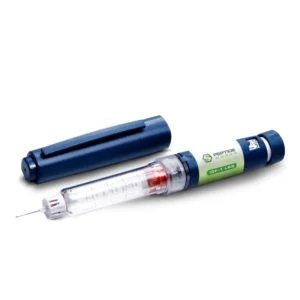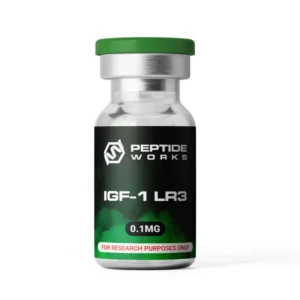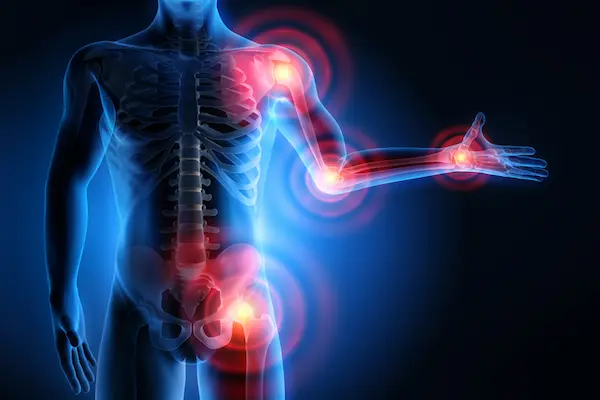Buy IGF-1 LR3 Peptide Nasal Spray from Peptide Works. Available in 15 ml and 30 ml glass spray bottles, this non-invasive spray offers a simple and efficient way to support consistent and precise application.
PROMO!
First order? Get 10% OFF with this code: 1storder
Our Product Categories



IGF-1 LR3, or Insulin-like Growth Factor-1 Long R3, is a synthetic analog of IGF-1. It is designed to be more stable and last longer in the body. The peptide is often used to study how it affects cell growth, development, and repair. Because the peptide stays active longer than natural IGF-1, IGF-1 LR3 gives scientists more time to observe its effects.
IGF-1 LR3 is used in fields like molecular biology, regenerative medicine, and performance science. It’s a reliable model for studying growth pathways, making it valuable for both basic and applied research.
Peptide Sequence (IUPAC Condensed): MFPAMP LSSLFV NGPRTL CGAELV DALQFV CGDRGF YFNKPT GYGSSS RRAPQT GIVDEC CFRSCD LRRLEM YCAPLK PAKSA
Molecular Formula: C400H625N111O115S9
Molecular Weight: 9117.5 g/mol
Synonyms: Insulin-like Growth Factor-1 Long Arginine 3
View the IGF-1 LR3 COA
View the IGF-1 LR3 HPLC

IGF-1 LR3 is a modified version of the natural Insulin-like Growth Factor-1, designed for more potent research use. It works by attaching to IGF-1 receptors on cells, which then activate key internal cell pathways, including PI3K-Akt and MAPK. The PI3K-Akt pathway helps cells survive, grow, and manage their metabolism, while the MAPK pathway encourages cell proliferation and differentiation.
What makes IGF-1 LR3 unique is its ability to bypass IGF-binding proteins (IGFBPs), which usually limit IGF-1’s effects. This means it stays active longer and is easier for the body to use. Researchers often turn to IGF-1 LR3 to understand its role in muscle growth, tissue repair, and recovery, making it an important tool in regenerative medicine, molecular biology, and performance science.
Buy IGF-1 LR3 Peptide Vial from Peptide Works. Each vial contains high-purity lyophilized peptide available in 0.1 mg and 1 mg options, supplied individually or as complete kits that include bacteriostatic water and syringes for easy reconstitution.
Muscle Growth, Hypertrophy, and Regeneration:Studies show that IGF-1 LR3 helps muscles grow and repair. It does this by encouraging muscle cells to multiply, develop, and activate satellite cells. This also boosts protein production in muscles and aids in their repair [1].
Research also shows that IGF-1 LR3 activates the PI3K/Akt/mTOR pathway. This boosts protein synthesis and stops muscle breakdown by blocking pathways like NF-κB and Smad signaling. It also improves blood flow and angiogenesis, which helps with tissue repair. Together, these actions make IGF-1 LR3 effective for muscle recovery and growth [2].
Improved Recovery & Tissue Repair: Research has shown that IGF-1 LR3 significantly enhances recovery and tissue repair by promoting cell proliferation, matrix synthesis, and regeneration. In muscle, IGF-1 accelerates repair after atrophy or damage, reducing muscle injury markers and boosting regeneration through increased MyoD expression and satellite cell activation [3].
It also improves nerve regeneration, enhancing axon growth, myelination, and neuromuscular junction preservation [4]. Additionally, IGF-1 supports tendon healing by stimulating collagen I production and tenocyte proliferation, improving structural integrity and recovery outcomes [5].
Body-Composition Effects: Fat Loss and Lean Mass Preservation: Research suggests that IGF-1 LR3 supports fat loss and lean mass preservation by influencing body composition. In a study, IGF-1 levels were inversely correlated with visceral fat in obese females, reflecting reduced intra-abdominal fat mass.
During moderate calorie restriction, IGF-1 levels temporarily increased, aiding fat loss while preserving lean tissue. Additionally, IGF-1 was inversely associated with blood glucose levels, highlighting its role in metabolic regulation and promoting healthier body composition during weight loss efforts [6].
Improved Nutrient Absorption and Metabolic Benefits: Research suggests IGF-1 LR3 enhances nutrient uptake and metabolic function by promoting amino acid and glucose absorption into muscle cells, supporting anabolic growth. Its insulin-like effects improve glucose metabolism, potentially aiding in conditions like metabolic syndrome.
Studies link IGF-1 deficiency to impaired lipid profiles, insulin resistance, and cardiovascular risks. IGF-1 replacement therapy, within physiological ranges, may restore metabolic balance, improving carbohydrate and lipid metabolism while supporting overall metabolic health and nutrient utilization [7].
Neuroprotective Effects: Research indicates that IGF-1 LR3 offers neuroprotective benefits by promoting brain development, synaptic plasticity, and neuronal survival. It activates PI3K/Akt and MAPK pathways, preventing neuronal death caused by amyloidogenesis, glucose deprivation, neuroinflammation, and apoptosis [8].
Studies show IGF-1 supports cognitive function, combats neurodegenerative processes, and enhances synaptic formation and autophagy. Its ability to cross the blood-brain barrier makes it a promising therapeutic target for neurodegenerative and neuropsychiatric disorders, potentially mitigating age-related cognitive decline and neurological dysfunction [9].
Potential Anti-Aging Benefits: Research indicates IGF-1 LR3 supports anti-aging by enhancing skin health and reducing visible signs of aging. Studies show that higher IGF-1 bioavailability, measured by the IGF-1 to IGFBP3 ratio, is associated with lower perceived age and reduced skin wrinkling.
IGF-1 promotes collagen expression and inhibits collagenases, preserving skin elasticity and structure. By improving fibroblast function and reducing wrinkle formation, IGF-1 LR3 may help maintain youthful skin and slow the visible effects of aging [10].
Regulation of the Immune System: Research indicates that IGF-1 LR3 influences the immune system by regulating cell cycle progression, apoptosis, and protein translation through IGF-1 receptor (IGF-IR) signaling. Studies show this pathway modulates the quality and amplitude of immune responses and may protect against autoimmune conditions like insulin-deficient diabetes. However, IGF-IR overexpression is linked to autoimmune diseases like Graves’ disease. IGF-1 LR3’s role in immune regulation highlights its potential as a therapeutic target for managing immune-related and autoimmune disorders [11].
Cardioprotective Properties: Studies have shown that IGF-1 LR3 supports cardiovascular health by promoting cardiac development, improving heart function, and enhancing metabolic processes. IGF-1 increases cardiac output, stroke volume, contractility, and ejection fraction, aiding recovery after myocardial infarction.
It also improves lipid profiles, lowers insulin levels, and enhances glucose metabolism and insulin sensitivity. Low IGF-1 levels are linked to higher cardiovascular risk, highlighting its therapeutic potential in managing cardiovascular diseases and improving overall heart health [12].
Buy IGF-1 LR3 Pre-Mixed Peptide Pen from Peptide Works. Each 1 mg cartridge can be purchased individually or as part of a complete kit that includes a reusable pen, needle tips, and a carry case for convenient and accurate preparation.
[1] S Sayeed Ahmad, K Ahmad, E Ju Lee, Y-H Lee, and I Choi (2020) Implications of Insulin-Like Growth Factor-1 in Skeletal Muscle and Various Diseases – Cells, 2020 Jul 24, Volume 9 (Issue 8), Page 1773.
[2] T Yoshida and P Delafontaine (2020) Mechanisms of IGF-1-Mediated Regulation of Skeletal Muscle Hypertrophy and Atrophy – Cells, 2020 Aug 26, Volume 9 (Issue 9), Page 1970.
[3] Fan Ye, Sunita Mathur, Min Liu, Stephen E Borst, et al (2016) Overexpression of IGF-1 attenuates skeletal muscle damage and accelerates muscle regeneration and functional recovery after disuse – Experimental Physiology, 2013 Jan 4, Volume 98 (Issue 5), Pages 1038–1052.
[4] Peter J Apel, Jian Jun, Michael Callahan, Casey N Northam, et al (2010) Effect of Locally Delivered IGF-1 on Nerve Regeneration During Aging: An Experimental Study in Rats – Muscle Nerve, 2010 Mar, Volume 41 (Issue 3), Pages 335–341.
[5] I Miescher, J Rieber, M Calcagni, and J Buschmann (2023) In Vitro and In Vivo Effects of IGF-1 Delivery Strategies on Tendon Healing: A Review – International Journal of Molecular Sciences, 2023 Jan 25, Volume 24 (Issue 3), Page 2370.
[6] M H Rasmussen, J Frystyk, T Andersen, L Breum, et al (1994) The impact of obesity, fat distribution, and energy restriction on insulin-like growth factor-1 (IGF-1), IGF-binding protein-3, insulin, and growth hormone – Metabolism, 1994 Mar, Volume 43 (Issue 3), Pages 315-9.
[7] G. A. Aguirre, J. Rodríguez De Ita, R. G. de la Garza and I. Castilla-Cortazar (2016) Insulin-like growth factor-1 deficiency and metabolic syndrome – Journal of Translational Medicine volume 14, Article number: 3 (2016).
[8] S Wrigley, D Arafa, and D Tropea (2017) Insulin-Like Growth Factor 1: At the Crossroads of Brain Development and Aging – Frontiers in Cellular Neuroscience, 2017 Feb 1, Volume 11, Page 14.
[9] S Bhalla, S Mehan, A Khan, and M U Rehman (2022) Protective role of IGF-1 and GLP-1 signaling activation in neurological dysfunctions – Neuroscience and Biobehavioral Reviews, 2022 Nov, Volume 142, Page 104896.
[10] R Noordam, D A Gunn, C C Tomlin, A B Maier, et al (2013) Serum insulin-like growth factor 1 and facial ageing: high levels associate with reduced skin wrinkling in a cross-sectional study – British Journal of Dermatology, 2013 Mar, Volume 168 (Issue 3), Pages 533-8.
[11] T J Smith (2010) Insulin-Like Growth Factor-I Regulation of Immune Function: A Potential Therapeutic Target in Autoimmune Diseases? – Pharmacological Reviews, 2010 Jun, Volume 62 (Issue 2), Pages 199–236.
[12] M Macvanin, Z Gluvic, J Radovanovic, M Essack, et al (2023) New insights on the cardiovascular effects of IGF-1 – Frontiers in Endocrinology (Lausanne), 2023 Feb 9, Volume 14, Page 1142644.
The answers to the most frequently asked questions about IGF-1 LR3.

Buy IGF-1 LR3 Peptide Nasal Spray from Peptide Works. Available in 15 ml and 30 ml glass spray bottles, this non-invasive spray offers a simple and efficient way to support consistent and precise application.
In animal studies, IGF-1 LR3 helped increase muscle repair and organ growth by boosting signals that support cell activity and recovery. These effects suggest possible roles in maintaining strength and vitality. However, research has not confirmed these effects in humans, so its anti-aging benefits remain unproven.
Yes, IGF-1 LR3 is banned in sports. The World Anti-Doping Agency (WADA) lists IGF-1 and its analogs, including IGF-1 LR3, as prohibited substances. They are banned because they can enhance muscle growth, recovery and performance. Athletes who use IGF-1 LR3 may face penalties if detected during anti-doping tests.
Animal studies show IGF-1 LR3 can cause organ growth and changes in insulin and blood sugar levels. Long-term use may lead to tissue overgrowth or metabolic imbalance. Research on lasting side effects is limited, so its long-term safety and overall health impact remain unclear.
IGF-1 LR3 is not approved by the U.S. Food and Drug Administration (FDA) for human use. It can be legally sold and purchased only for laboratory or research purposes. Regulations vary by country, as some regions classify IGF-1 LR3 under controlled or prescription-only substances, while others allow it for research use.

This article explores IGF-1 LR3 as a muscle recovery peptide, focusing on its ability to boost protein synthesis through mTOR activation. It draws comparisons between IGF-1 LR3, BPC-157, and TB500, examining their distinct mechanisms for muscle repair, tissue healing, and inflammation reduction. The discussion also touches upon recent research findings and potential future uses in the field.

This blog explores the fat loss potential of LR3 peptide, a modified IGF-1 variant. It highlights its ability to enhance lipolysis, preserve muscle mass, and activate fat breakdown mechanisms through IGF-1 receptor pathways. The blog also examines related peptides, their unique mechanisms, and the future of metabolic research in fat loss applications.

This blog looks at the role of Somatropin Growth Hormone and related peptides in bone and joint health. It discusses their potential to improve bone density, support cartilage repair, and aid tissue regeneration. Peptides such as HGH-191AA, IGF-1 LR3, MK-677, and BPC-157 are also evaluated for their specific roles in skeletal strength and joint recovery within research studies.
ALL CONTENT AND PRODUCT INFORMATION AVAILABLE ON THIS WEBSITE IS FOR EDUCATIONAL PURPOSES ONLY.
DISCLAIMER: These products are intended solely as a research chemical only. This classification allows for their use only for research development and laboratory studies. The information available on our Peptide Works website: https://peptide-works.com/ is provided for educational purposes only. These products are not for human or animal use or consumption in any manner. Handling of these products should be limited to suitably qualified professionals. They are not to be classified as a drug, food, cosmetic, or medicinal product and must not be mislabelled or used as such.